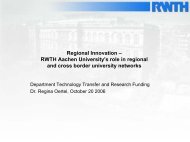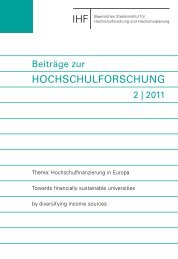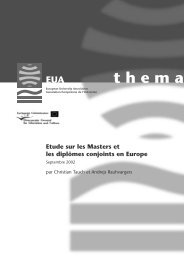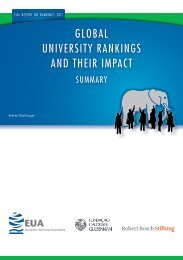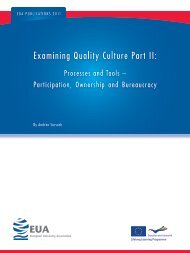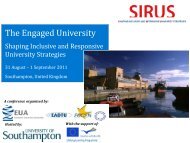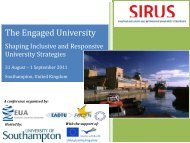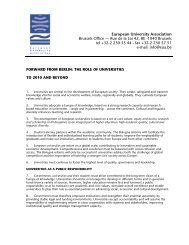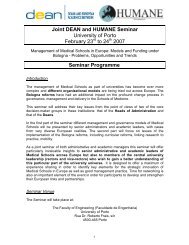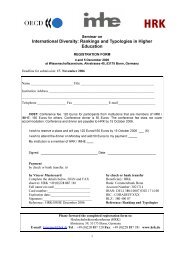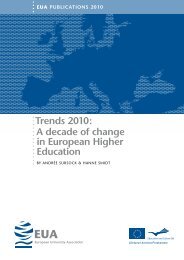EUA Annual Report 2010 - European University Association
EUA Annual Report 2010 - European University Association
EUA Annual Report 2010 - European University Association
Create successful ePaper yourself
Turn your PDF publications into a flip-book with our unique Google optimized e-Paper software.
annual report <strong>2010</strong><br />
The meaning of structure<br />
Structuring doctoral education is to<br />
create a supportive environment.<br />
Setting up structures means taking<br />
institutional responsibility for training<br />
through research, as defined in the<br />
second Salzburg Principle. Doctoral<br />
education is an individual journey,<br />
and structures must give support<br />
to individual development, and not<br />
produce uniformity or predictability. The<br />
goals of structuring doctoral education<br />
must be to assure diverse and inclusive<br />
research environments of a high quality<br />
as the basis of doctoral education.<br />
This includes critical mass, transparent<br />
admission procedures and high quality<br />
of supervision.<br />
Structuring doctoral education also<br />
means achieving flexible structures<br />
to expose early stage researchers to a<br />
wide range of opportunities, ensuring<br />
personal and professional development<br />
and to provide institutional support<br />
for career development and mobility.<br />
Taught courses are to be seen as a<br />
support to the individual professional<br />
development of doctoral candidates;<br />
they are not central to the meaning of<br />
structure.<br />
When establishing structures, the<br />
importance of diversity as stressed in<br />
the third Salzburg Principle is crucial.<br />
Many different structures and diverse<br />
strategies will enrich doctoral education<br />
in Europe.<br />
Structures should be developed at<br />
the appropriate level of governance<br />
and not be imposed on or within the<br />
institution. It is essential that academic<br />
staff takes responsibility and ownership<br />
of these structures through inclusive<br />
procedures.<br />
2. ClUEs for sUCCEss<br />
2.1. Critical mass and critical diversity<br />
Doctoral education is dependent on the<br />
research environment. Institutions must<br />
develop a critical mass and diversity of<br />
research in order to offer high quality<br />
doctoral education. Critical mass does<br />
not necessarily mean a large number of<br />
researchers, but rather the quality of the<br />
research. In line with the sixth Salzburg<br />
Principle, Europe’s universities have<br />
developed diverse strategies to assure<br />
critical mass and diversity, building their<br />
areas of strength through focused research<br />
strategies and engaging in larger research<br />
networks, collaborations or regional<br />
clusters.<br />
2.2. Recruitment, admission and status<br />
Structured programmes should develop<br />
recruitment strategies that correspond<br />
to their particular mission and profile.<br />
Recruitment strategies should be<br />
connected to explicit outcomes,<br />
identifying clear profiles of the candidates<br />
wanted. Such profiles should build<br />
on the parity of esteem of a range of<br />
different qualities and ensure equality of<br />
opportunity. In this manner, recruitment<br />
policies could take into account criteria<br />
such as international recruitment, gender<br />
equality, social background or different<br />
age groups. Recruitment should value<br />
the research potential of the candidates<br />
over past performance and above all<br />
the candidates’ potential to succeed in<br />
the programme to which they are being<br />
admitted.<br />
Admission to a doctoral programme is<br />
an institutional responsibility, which<br />
must include the strong involvement of<br />
research staff. Admissions policies must<br />
be transparent and accountable and<br />
should reflect the research, supervisory<br />
and financial capacity of the institution.<br />
AnnExEs<br />
53



